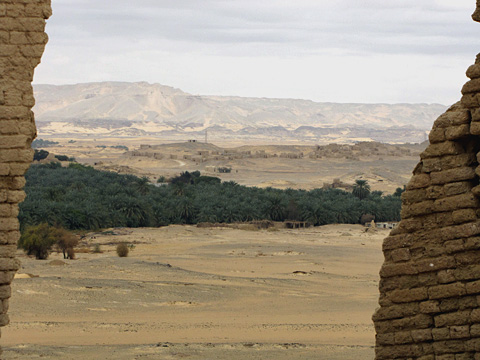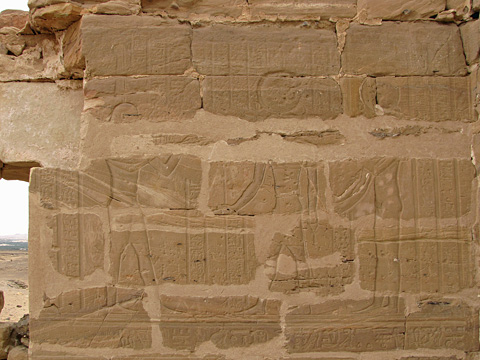Fortress & Temple at Nadura
At Nadura, whose name means ‘The Lookout’, remains of a temple once enclosed within a Roman fortification are strategically perched high on a hilltop about 1.5km north-east of the centre of el-Kharga. From the top of the hill there are spectacular views over the Oasis with the monuments of Hibis Temple and el-Bagawat cemetery clearly seen in the distance.

The settlement of Nadura is now buried and the two temples of the village are badly ruined, but the southern entrance wall of the main temple can still be seen on top of the hill.

The main temple was built during the rule of Hadrian and Antoninus Pius during the 2nd century AD. A sandstone gate in the southern crumbling enclosure wall fronts a courtyard which contained the three rooms of the temple. Another smaller entrance was through the northern wall. Remains of the pronaos on the western side of the structure can still be seen, but the vestibule and sanctuary have now virtually disappeared, buried by sand. The façade of the pronaos, typical of the period, had screen walls linked by columns and is decorated inside with figures and hieroglyphic texts.

Originally thought perhaps to be outposts of the large and well-preserved Temple of Amun at Hibis, 2km to the north-west, it has been difficult to know to which deities these two temples were dedicated, largely because of the deteriorated condition of the remaining reliefs. Since early explorers first documented the temple, speculation on the specific deities honoured here have been widespread. There are some suggestions that the goddess Mut was the temple’s main deity as she appears in several reliefs, as does Amun, Khonsu, Ihy, Thoth and Bes, while others have associated Amun of Hibis, a local form of Amun worshipped at Hibis Temple.

In 2009, Yale University began its Nadura Temple Project with the aim to provide a complete epigraphic documentation of the reliefs and inscriptions. They also started an archaeological and architectural survey of the site as well as clearance of the mostly destroyed sanctuary area. The Yale project team’s findings so far are interesting in that it is now suggested from textural evidence that the temple is most likely to have been dedicated to Khonsu, the son of Amun and Mut, as he predominates the reliefs, especially in one unique relief where the deity stands before Amun in a position of honour.

A Coptic church once stood within the space outside the temple and the whole structure was later reused as a Turkish fortress during the Mamaluk and Ottoman Periods. Remains of the second uninscribed temple can be seen at the base of the hill towards the main road.
For more information see the Yale Nadura Project by the Yale Egyptological Institute in Egypt.
